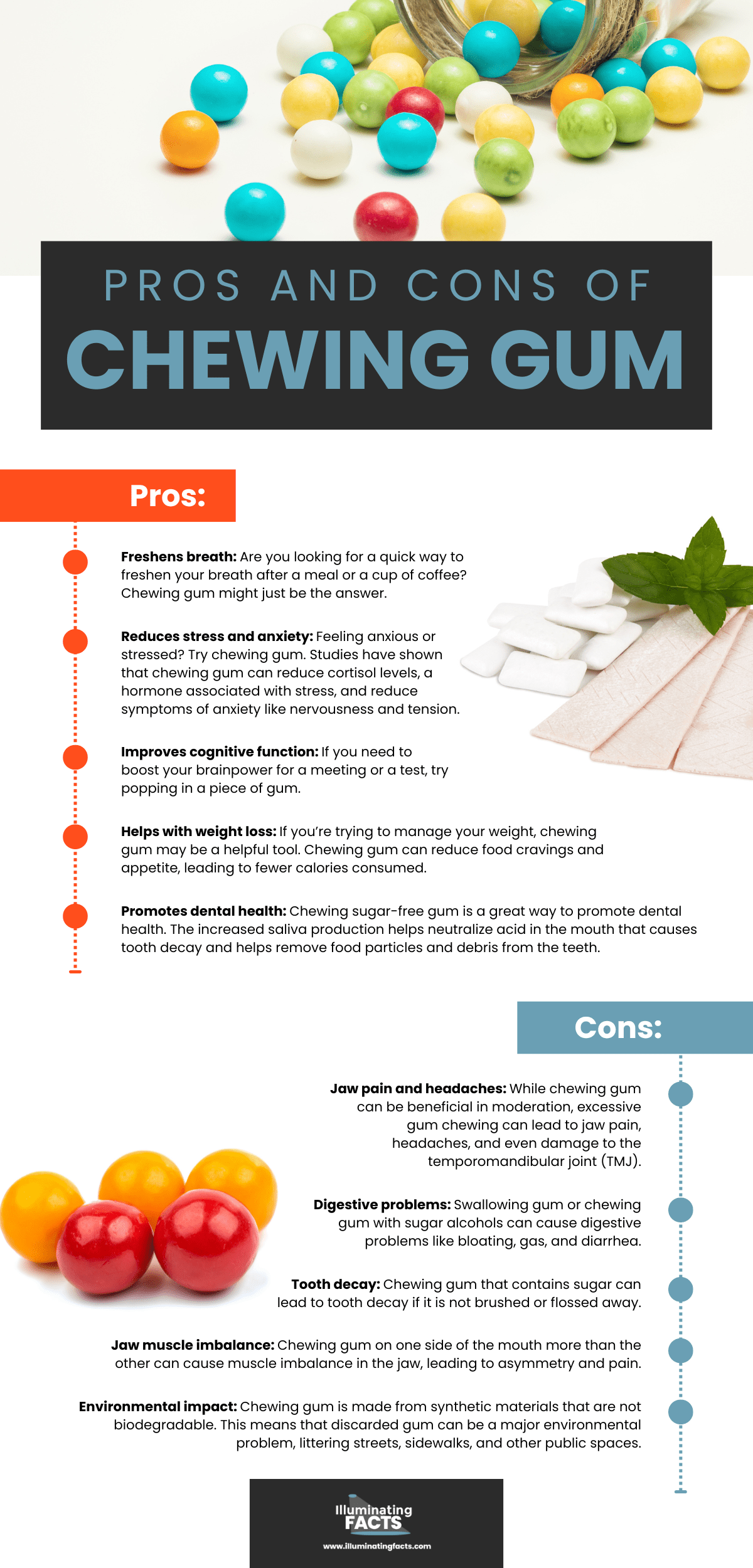Chewing gum is one of those ubiquitous little pleasures we often take for granted. But the history of this seemingly innocuous habit is far more fascinating than most of us imagine. From ancient cultures to modern-day factories, the story of gum is a true testament to human ingenuity and resourcefulness.
So, where did this habit begin? Was it a staple among ancient civilizations? Or did it emerge more recently in modern times? And what about the benefits and drawbacks? Is it truly beneficial or detrimental to our health?
In this article, we’ll explore the origins and evolution of chewing gum, from its earliest origins to its modern-day production. We’ll also delve into the potential advantages and disadvantages of this common habit, giving you a comprehensive view of this popular pastime. So buckle up and let’s chew on some facts about gum.
Brief history of chewing gum
Chewing gum has a long and interesting history. People have chewed gum in various forms for thousands of years, including sweet types of grass, leaves, grains, waxes, and tree resin lumps. In 1848, John Bacon Curtis created the first commercial chewing gum made from spruce gum, which he sold as the State of Maine Pure Spruce Gum. [1] Amos Tyler received the first patent in the United States for chewing gum in 1869, but it was William Finley Semple who used the first patent for manufacturing chewing gum using charcoal and chalk.
Mexican General Antonio Lopez de Santa Anna shared his idea of chicle with Thomas Adams, who tried to make toys, masks, and rain boots out of chicle but was unsuccessful. In 1869, he added flavor to the chicle and created the world’s first modern chewing gum, which he sold as Adams New York Chewing Gum. [2] The problem with holding flavor was not fixed until 1880 when William White combined sugar and corn syrup with chicle and added peppermint extract to create Yucatan gum, which held its flavor during chewing for much longer than other flavors.
Dr. Edward Beeman invented gum that was supposed to serve as a “digestive aid” by adding pepsin powder, which was a significant discovery in the world of chewing gums. In 1888, Tutti-Frutti became the first gum to be sold commercially in a vending machine. It was invented by Thomas Adams, who had a different vision for gums. [3] By the early 1900s, modern chewing saw a drastic increase in popularity.
In 1914, the world was introduced to Wringley’s Doublemint. This was made from mint and fruit extracts being added to chewing gum with chicle. The creation brought global success to the Wrigley Company, which was spearheaded by Henry Fleer and Willian Wrigley. In 1928, Walter Diemer accidentally found bubble gum that was not sticky and called it Double Bubble, based on the original Frank Fleer formula. [4] The Topps Company reinvented the popularity of bubble gum in 1951 by adding baseball cards to a package, and in the 1950s, sugarless gum was introduced as consumers became more health-conscious. The idea behind sugar-free gum belonged to a dentist, Dr. Petrulis, and the “dentist-approved” chewing gums contain Ammonia, which counteracted acid and prevented tooth decay.
Ancient cultures and chewing gum
Most people associate chewing gum with pop culture and iconic brands that have come to dominate the market. However, the origin of chewing gum dates back much further than most people imagine. Greeks, Mayans, and other ancient cultures were known to chew on various substances for both medicinal and recreational purposes.
According to a fascinating article on History.com [5], the ancient Greeks chewed on mastiche, a resin from the mastic tree, which was believed to freshen breath and soothe stomach ailments. Meanwhile, the Mayans would chew on chicle, a substance made from the sap of the sapodilla tree, for both practical and religious purposes. Chewing chicle was said to help relieve thirst and hunger, as well as provide a way to communicate with the gods.
In certain cultures, chewing gum was also used as a form of entertainment. The Aztecs would pass around balls of chicle during social gatherings and chew on it while they danced and socialized. The practice of chewing gum was so popular in ancient cultures that it continued for centuries and eventually spread throughout the world.
Interestingly, the modern era of chewing gum has seen a number of iconic brands rise to prominence, such as Juicy Fruit, Doublemint, and Trident. Today, chewing gum is a multi-billion dollar industry that continues to evolve and innovate.
So while chewing gum may seem like a modern invention, its history stretches back thousands of years. From ancient cultures using natural resins and sap to modern-day brands with sophisticated flavors and packaging, chewing gum has come a long way since its humble beginnings.
Modern era and chewing gum
Chewing gum has come a long way since its specific uses in the ancient times. From its manufacturing volume to the way its consumed, it has had a significant impact on modern society.
One significant change in gum production and consumption is the shift towards artificial sweeteners. According to Serious Eats, sugar was the primary sweetener until the 1960s. [6] That said, advancements in technology have enabled companies to turn to artificial sweeteners like aspartame and xylitol. The use of these sweeteners allows for sugar-free options, which appeals to a more health-conscious market.
Another significant change in modern gum is its purpose. Chewing gum was once just a fun activity, but it now serves many practical purposes. Gum is a common tool for freshening breath, improving focus, and even alleviating stress. It is also a common sight in workplaces, schools, and other public places, as it is thought to be an effective tool for improving productivity and focus.
Gum has also played a role in marketing and advertising. Companies like Wrigley’s have used celebrities like William Shatner and Rob Lowe to endorse their products. In 2007, Wrigley’s famously aired an ad during the Super Bowl featuring a kiss between two men, which sparked a conversation about acceptance and inclusivity in advertising.
Finally, gum has also had an environmental impact. [7] The production and disposal of gum can lead to litter and environmental pollution. As a result, many cities have placed bans on gum sales or instituted programs to dispose of gum properly.
Overall, chewing gum has come a long way from its ancient origins, and it is now an essential item in modern society. With changes in sweeteners, practical uses, and advertising, it has become a ubiquitous presence in our lives. Still, it is essential to consider its environmental impact and dispose of it properly.
Pros and cons of chewing gum
It’s no secret that people of all ages chew gum. Some individuals chew it to freshen their breath, while others use it as a means of stress release or to enhance their cognitive function. However, there are both benefits and downsides to this habit.
Pros:
Freshens breath: Are you looking for a quick way to freshen your breath after a meal or a cup of coffee? Chewing gum might just be the answer. Chewing gum helps produce saliva, which washes away bacteria and food particles that cause bad breath.
Reduces stress and anxiety: Feeling anxious or stressed? Try chewing gum. Studies have shown that chewing gum can reduce cortisol levels, a hormone associated with stress, and reduce symptoms of anxiety like nervousness and tension.
Improves cognitive function: If you need to boost your brainpower for a meeting or a test, try popping in a piece of gum. Chewing gum has been shown to increase blood flow and oxygen to the brain, leading to better cognitive performance and improved memory, attention, and concentration.
Helps with weight loss: If you’re trying to manage your weight, chewing gum may be a helpful tool. Chewing gum can reduce food cravings and appetite, leading to fewer calories consumed. One study found that chewing gum reduced participants’ calorie intake by an average of 68 calories per snack. [8]
Promotes dental health: Chewing sugar-free gum is a great way to promote dental health. The increased saliva production helps neutralize acid in the mouth that causes tooth decay and helps remove food particles and debris from the teeth.
Cons:
Jaw pain and headaches: While chewing gum can be beneficial in moderation, excessive gum chewing can lead to jaw pain, headaches, and even damage to the temporomandibular joint (TMJ). This is especially true for people who chew gum for long periods or chew multiple pieces at once.
Digestive problems: Swallowing gum or chewing gum with sugar alcohols can cause digestive problems like bloating, gas, and diarrhea. These side effects are more likely to occur in people with irritable bowel syndrome (IBS) or other digestive disorders.
Tooth decay: Chewing gum that contains sugar can lead to tooth decay if it is not brushed or flossed away. While sugar-free gum is a better option for dental health, it should still be chewed in moderation.
Jaw muscle imbalance: Chewing gum on one side of the mouth more than the other can cause muscle imbalance in the jaw, leading to asymmetry and pain.
Environmental impact: Chewing gum is made from synthetic materials that are not biodegradable. This means that discarded gum can be a major environmental problem, littering streets, sidewalks, and other public spaces. To minimize the environmental impact of gum, dispose of it properly in a trash can.
Interesting facts1. The world’s oldest piece of chewing gum is 10,000 years old. It was found in Sweden and is made from birch bark tar. 2. During World War II, the US government included chewing gum in soldiers’ rations as a way to help them stay alert and relieve stress. 3. Chewing gum was banned in Singapore in 1992 because of the litter it caused. Today, selling or importing gum is still illegal, except for therapeutic gum approved by the government. 4. The largest bubblegum bubble ever blown measured 23 inches in diameter and was achieved by Susan Montgomery Williams of California in 1996. 5. Chewing gum has been taken to space by astronauts. It was first brought on a space mission in 1964 by the crew of Gemini 3. 6. There is a Guinness World Record for the most pieces of gum chewed at once. The current record is held by American Chad Fell, who chewed 465 pieces of gum at once in 2004. 7. The first bubblegum was invented by Walter Diemer, an accountant at Fleer Chewing Gum Company, in 1928. He used a recipe that was less sticky than regular chewing gum and could be blown into bubbles. 8. Chewing gum has been used to help people quit smoking. Nicotine gum, which contains small amounts of nicotine, can help reduce cravings and withdrawal symptoms for people trying to quit smoking. |
Conclusion
The origins of chewing gum are rooted in ancient history and have evolved over time to become a modern staple in our daily lives. From the ancient Maya and Aztecs to the early 19th century in America, chewing gum has been used for its medicinal properties, to aid digestion, and freshen breath.
As the industrial revolution took hold, the production and commercialization of gum exploded, with brands like Wrigley’s and Chiclets leading the way. Today, chewing gum is a global industry worth billions of dollars and comes in a variety of flavors and types, from sugar-free to nicotine-infused.
Here are some key points to recap on the origins of chewing gum:
- Ancient civilizations such as the Greeks and Mayans were known to chew on tree resins for medicinal purposes.
- In the 1800s, modern chewing gum as we know it today was invented by John B. Curtis and William Semple, who created a gum made from tree resin and paraffin wax.
- In the late 1800s, gum makers started marketing the staple as a commercial product, using advertising and giveaways to make it popular.
- Chewing gum has numerous benefits, including freshening breath, reducing stress and anxiety, improving cognitive function, helping with weight loss, and promoting dental health.
- However, there are also some cons to chewing gum, such as causing jaw pain and headaches, digestive problems, tooth decay, jaw muscle imbalance, and environmental impact.
Despite the potential downsides, the popularity of chewing gum continues to grow. With ongoing advancements in technology and research, it’s possible that we will see even more innovations in the world of gum in the future.
References:
1. John B. Curtis. (n.d.). Chewing Gum Facts. https://www.chewinggumfacts.com/chewing-gum-inventors/john-b-curtis/
2. Nikki. (2008, December 19). Featured invention: Chewing gum. Davison. https://www.davison.com/blog/featured-invention-chewing-gum/
3. Kdadmin. (2022, August 10). The history of vending machines. Logic Vending. https://www.logicvending.co.uk/history-vending-machine
4. Qrius. (2018, March 24). Who invented bubblegum and what did the first gum taste like?https://qrius.com/who-invented-bubblegum-and-what-did-first-gum-taste-like/
5. Nix, E. (2015, February 13). Chew on this: The history of gum. HISTORY. https://www.history.com/news/chew-on-this-the-history-of-gum
6. The history of chewing gum, from chicle to Chiclets. (2017, July 17). Serious Eats. https://www.seriouseats.com/chewing-gum-history-how-its-made
7. Improper disposal of non-biodegradable chewing gum is one of the biggest threats to our ecology: A review. (n.d.). Current World Environment – International Research Journal of Environment Science. https://www.cwejournal.org/vol16no3/improper-disposal-of-non-biodegradable-chewing-gum-is-one-of-the-biggest-threats-to-our-ecology–a-review
8. Study finds chewing gum can help lower calorie intake and increase energy expenditure. (n.d.). EurekAlert!. https://www.eurekalert.org/news-releases/662395





